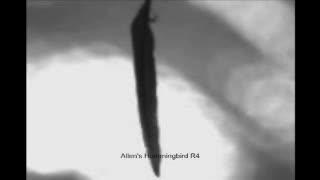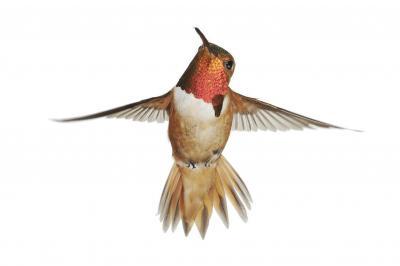When diving during their courtship dances, male hummingbirds exceed their usual flight speeds--with birds of at least some hummingbird species reaching their possible maximum speeds during dives. Also, the faster a male hummingbird dives, the louder his fluttering sounds become.
In addition to diving during courtship rituals, a male hummingbird may also brandish showy ornaments and produce sounds from other feathers besides his tail feathers. Females choose a mate from among available males.Clark is unsure why male hummingbirds have evolved an ability to generate sounds with their tail feathers during courtship. But he offers two explanatory hypotheses.
According to the first hypothesis, it could be that female hummingbirds prefer to mate with the best flyers because of their relatively high fitness and that females use the volume of a suitor's tail feathers as a proxy for his fitness. If this were the case, perhaps males dive fast in order to increase the volume of their fluttering and thereby appeal to volume seeking female hummingbirds. The loudest males would thereby gain a selective advantage and be favored by evolution.
Clark notes that common sense says fluttering sounds generated by actual flight would provide a more accurate proxy of a bird's flying prowess than would vocal signals generated by mechanisms unrelated to flight.According to Clark's second hypothesis, it could be that the sound of the hummingbirds' tail feathers developed incidentally to the birds' flying abilities without such sound serving any particular purpose--similar to the way that the sound of peoples' footsteps apparently developed incidentally to the ability to walk without such sounds serving any particular purpose. At the same time, it could be that female hummingbirds prefer the loudest males for reasons not related to their flying prowess. If this were the case, the loudest males would still have a selective advantage and would be favored by evolution.
"This work is an excellent example of the use of physical approaches to understand the function of biological structures, and it reveals aerodynamic--rather than vocalized--signaling during courtship," said William Zamer, who directs NSF's Ecological and Evolutionary Physiology program. "It is significant that the diversity of feather structures in these hummingbirds may result from sexual selection."
Clark analyzed the fluttering sounds of hummingbird feathers by measuring the fluttering feathers with a Scanning Laser Doppler Vibrometer--an instrument that is used to measure the vibrations of a surface--and by viewing high speed videos of the tail feathers of hummingbirds in a wind tunnel.
Clark notes that the aluminum wings of airplanes may also flutter as air flows over them, and in the absence of engineering controls, may even break because of such fluttering. Presumably, hummingbird feathers do not break when they flutter because they are less brittle than aluminum airplane wings, and so can bend more without being damaged.

Christopher Clark explains his research into the sounds male hummingbirds create with their tails.
(Photo Credit: Christopher Clark, Yale)

When males perform courtship dives for females, neighboring fluttering tale feathers produce interaction frequencies. In some species, for or five species may interact with one another to produce sounds.
(Photo Credit: Anand Varma, www.varmaphoto.com)
Source: National Science Foundation